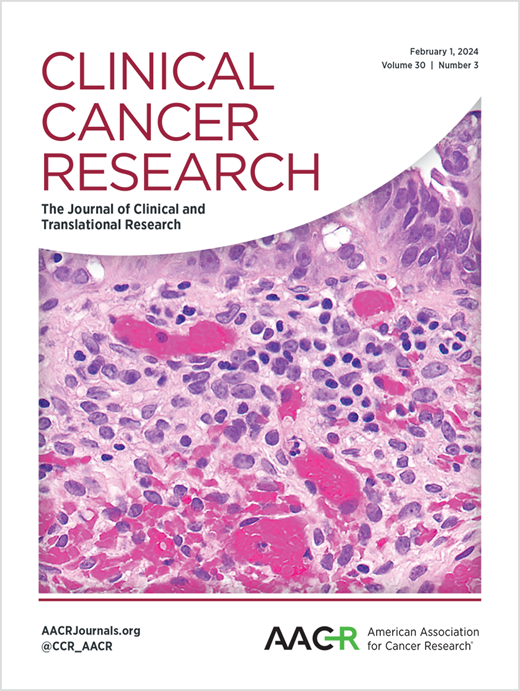奥拉帕尼联合胸部放射治疗广泛期小细胞肺癌的一期剂量递增试验
IF 10.2
1区 医学
Q1 ONCOLOGY
引用次数: 0
摘要
目的:广泛期小细胞肺癌(ES-SCLC)患者通常采用诱导全身治疗和巩固性胸部放射治疗(TRT)。PARP抑制剂在临床前肺癌模型中显示出放射致敏性。我们进行了一项研究者发起的、多机构、单臂、开放标签的奥拉帕尼联合TRT的I期研究。患者和方法:诱导后铂/依托泊苷+/-阿特唑单抗无进展的患者口服奥拉帕尼治疗3周,并在第2周和第3周同时使用低剂量TRT (30 Gy/10份)。奥拉帕尼剂量开始为50mg,每日两次,以50mg/剂量增量递增,每组3例患者。主要目的是奥拉帕尼+ TRT的安全性和最大耐受剂量。次要目标包括现场局部复发率、无进展生存期(PFS)和总生存期(OS)。结果:在2018年10月至2022年3月期间,24例中位年龄为68岁的患者接受了铂/依托泊苷和30 Gy/10分数TRT的治疗(中位随访11.4个月);10名患者也接受了atezolizumab治疗。奥拉帕尼与TRT的MTD为200mg,每日2次。有3个3级(G3)剂量限制性不良事件(ae),包括肺炎/肺炎、食管炎和腹痛。最常见的G2-3治疗相关ae是食管炎(n=12)和肺炎/肺炎(n=2)。无G4或5 ae。12个月累积局部复发率为27%,中位PFS和OS分别为3.6个月和17.7个月。结论:本研究确定了MTD和推荐的II期剂量200mg奥拉帕尼,每日两次,同时使用低剂量TRT,并且联合使用似乎是安全的,没有意外的毒性。本文章由计算机程序翻译,如有差异,请以英文原文为准。
Phase I Dose Escalation Trial Combining Olaparib and Thoracic Radiation Therapy in Extensive-Stage Small Cell Lung Cancer
Purpose: Patients with extensive-stage small cell lung cancer (ES-SCLC) are commonly treated with induction systemic therapy and consolidative thoracic radiation therapy (TRT). PARP inhibitors have demonstrated radiosensitization in preclinical lung cancer models. We performed an investigator-initiated, multi-institutional, single-arm, open label phase I study of concurrent olaparib with TRT. Patients and Methods: Patients without progression after induction platinum/etoposide +/- atezolizumab were treated with oral olaparib for 3 weeks and concurrent low-dose TRT (30 Gy/10 fractions) in weeks 2 and 3. Olaparib dose started at 50mg twice daily and escalated in 50mg/dose increments in cohorts of 3 patients each. Primary objectives were the safety and maximum tolerated dose (MTD) of olaparib + TRT. Secondary objectives included in-field local recurrence rate, progression-free survival (PFS), and overall survival (OS). Results: Between 10/2018 and 03/2022, 24 patients with a median age of 68 years were treated (median follow-up: 11.4 months) with platinum/etoposide and 30 Gy/10 fractions TRT; 10 patients also received atezolizumab. The MTD of olaparib with TRT was 200mg twice daily. There were 3 grade 3 (G3) dose-limiting adverse events (AEs), including pneumonitis/pneumonia, esophagitis, and abdominal pain. The most common G2-3 treatment-related AEs were esophagitis (n=12) and pneumonitis/pneumonia (n=2). There were no G4 or 5 AEs. The 12-month cumulative incidence of local recurrence was 27%, median PFS and OS were 3.6 months and 17.7 months, respectively. Conclusions: This study defined a MTD and recommended phase II dose of 200mg twice daily olaparib with concurrent low-dose TRT, and the combination appeared safe without unexpected toxicities.
求助全文
通过发布文献求助,成功后即可免费获取论文全文。
去求助
来源期刊

Clinical Cancer Research
医学-肿瘤学
CiteScore
20.10
自引率
1.70%
发文量
1207
审稿时长
2.1 months
期刊介绍:
Clinical Cancer Research is a journal focusing on groundbreaking research in cancer, specifically in the areas where the laboratory and the clinic intersect. Our primary interest lies in clinical trials that investigate novel treatments, accompanied by research on pharmacology, molecular alterations, and biomarkers that can predict response or resistance to these treatments. Furthermore, we prioritize laboratory and animal studies that explore new drugs and targeted agents with the potential to advance to clinical trials. We also encourage research on targetable mechanisms of cancer development, progression, and metastasis.
 求助内容:
求助内容: 应助结果提醒方式:
应助结果提醒方式:


